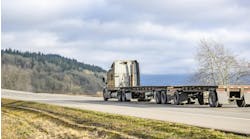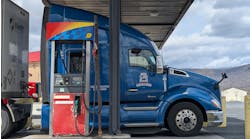Keeping freight at a temperature without traditional fuel and emissions is another emerging challenge for the transportation industry.
More than one of every seven straight trucks and trailers in the U.S. requires temperature control to keep their cargo safe. While most transportation refrigeration units are still diesel-powered, stricter emissions regulations are pushing fleets to adopt emerging electric TRUs for their refrigerated transportation operations.
While early zero-emission TRU regulations focus on California operations, the North American Council for Freight Efficiency has a new report detailing the challenges of decarbonizing the cold chain. NACFE leaders said their findings could help fleets inside and outside the Golden State prepare to adopt zero-emission refrigerated transport.
The cold chain is about keeping freight within certain temperatures from the first mile to the long haul to the final mile. This, of course, includes foods such as ice cream or frozen produce that must be kept below a certain temperature. It also includes products such as fresh produce, perishable foods, pharmaceuticals, electronics, and more that need to be kept within a certain temperature range.
NACFE published its first reefer-focused report, Decarbonizing Truck and Trailer Refrigeration, on October 17 to provide fleets with basic information about TRUs and the growing need for eTRU technology. The lengthy report outlines the ever-increasing needs, shifting landscape, challenges, and opportunities ahead for reefer fleets nationwide.
However, among the most pressing challenges is the California Air Resources Board’s eTRU regulatory push to phase out all diesel-powered straight truck TRUs and replace them with zero-emission solutions by 2030. Those regulations began in 2023 and equate to annually reducing 15% of non-tractor-trailer reefer operations with eTRUs.
Manufacturers are developing ways to harmonize the connectors and power requirements for charging electric trucks, charging eTRU batteries, and providing shore power when electric reefers are parked or idling.
Mike Roeth, NACFE executive director, equated the reefer regs to a tornado. “If you’re hit by the tornado, it’s a big deal; if you’re not, you just go on,” he said during a media briefing just before the report was released. “So if you’re not in refrigeration, this isn’t your problem. Or if you don’t operate in California, it’s not yet a challenge. But for where it is, we think it’s a pretty big challenge.”
But Roeth stressed that it’s worth it for all fleet leaders to learn from this report about trucking’s transformation beyond California and reefer operations because it’s not just about the engine under the hood. “Electric transformation in trucking is going to be more than just propulsion,” he said later in the briefing. “This is just going to continue, so I think it’s important to educate yourself on electrification. We say all the time: Go buy (an electric) yard tractor; go buy an electric pickup truck. Get in the game if you’re a fleet operator because it’s only going to grow more and more.”
Decarbonizing truck and trailer refrigeration
See also: NACFE Run on Less sets sights on trucking’s ‘messy middle’
NACFE’s findings on the state and future of reefer operations
Among the barriers to expanding eTRU use in transportation are battery size, weight, operational challenges, training, upfront costs, and (of course) infrastructure, according to the NACFE report. However, its benefits include reduced operating and maintenance costs for fleets and noise reduction that can benefit drivers.
“Most TRUs today are diesel-powered,” according to Rob Graff, NACFE senior technical consultant and lead author of the study. “These are increasingly subject to regulations on their emissions—including GHGs. We’ve seen the development of low- to no-emissions TRU technologies emerging to meet these requirements.”
See also: Fleets Explained: Emissions regulations
Graff and his colleagues said the study yielded six high-level findings:
Reefer operation population
Freight requiring specified-temperature-range transportation makes up about 15% of straight trucks and trailers.
Refrigerated and frozen foods, pharmaceuticals, other grocery items, and electronics are some commodities that require refrigeration. Other freight, such as fresh produce and paints, requires freeze protection during winter months. This is a significant—but often unrecognized—portion of North American freight requiring special straight trucks and trailers with diesel-powered transport refrigeration units.
Regulations and expectations
Regulations and increasing sustainability expectations are converging to require more sustainable solutions for moving refrigerated goods, according to the report.
CARB has been driving regulations that require zero-emission refrigeration and freeze protection for moving goods. This can be challenging as today’s diesel eTRUs run off the diesel truck’s engine or from dedicated engines integrated into the TRUs. These have long run times when vehicles are in motion or sitting at warehouses or stores to be loaded or unloaded.
Zero-emission TRU availability
New zero-emission refrigeration units are being developed to run on electricity.
Many forms of eTRUs are available or under development to respond to regulations and shipper expectations. These include all-electric units—some with significant battery storage—systems that accept plug-in shore power as a source and hybrid units that run primarily on electricity but have diesel or other powertrains to support long run times.
Other reefer solutions
Other allied solutions are emerging to power or replicate eTRUs.
These alternative solutions include increased insulation or incorporating cold plates into the truck or trailer bodies, solar generators or electric axles (or e-axles) to deliver more power to the batteries, and other innovative solutions.
See also: The major electric axles for commercial vehicles
Quality vs. reality
Moving and delivering refrigerated goods with zero- or near-zero emissions while maintaining quality is a significant operational challenge.
Although independent of electric truck propulsion units, these cleaner solutions compete for resources but also benefit from developments, such as improved battery size, weight, and cost. Delivering reliable, durable, and cost-effective solutions quickly has many challenges.
What’s next for zero-emission reefer fleets
Development is underway to plan for and harmonize the connectors and power requirements for charging electric trucks, charging eTRU batteries, and providing shore power when electric reefers are parked or idling.
The broad efforts to provide charging infrastructure for electric trucks should be expanded to incorporate the requirements of electric transport refrigeration units.
The report can be downloaded at NACFE's website.





